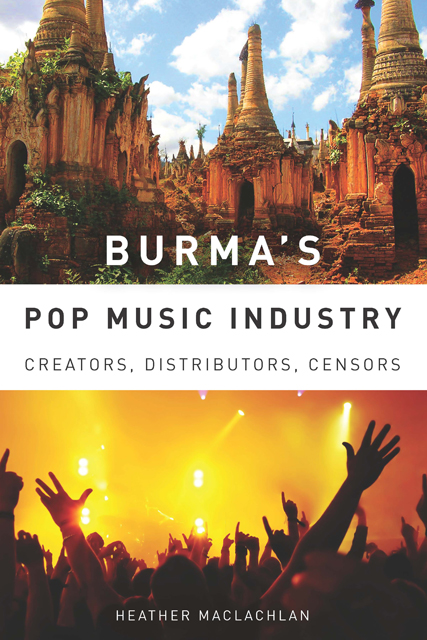Book contents
- Frontmatter
- Dedication
- Contents
- List of Illustrations
- Acknowledgments
- Introduction
- 1 The Creators of Burmese Pop Music
- 2 The Sound of Burmese Pop Songs
- 3 Learning Music in Burma Today
- 4 Six Facets of the Burmese Pop Music Industry
- 5 Musicians and the Censors: The Negotiation of Power
- Conclusion: The Significance of the Burmese Perspective
- Notes
- Bibliography
- Index
4 - Six Facets of the Burmese Pop Music Industry
Published online by Cambridge University Press: 11 February 2023
- Frontmatter
- Dedication
- Contents
- List of Illustrations
- Acknowledgments
- Introduction
- 1 The Creators of Burmese Pop Music
- 2 The Sound of Burmese Pop Songs
- 3 Learning Music in Burma Today
- 4 Six Facets of the Burmese Pop Music Industry
- 5 Musicians and the Censors: The Negotiation of Power
- Conclusion: The Significance of the Burmese Perspective
- Notes
- Bibliography
- Index
Summary
The Myaynigone junction, one of the biggest and busiest intersections in Yangon, is located on Pyay Lan (formerly Prome Road). This junction is well known to all city residents in part because in 2007 a huge electronic billboard, the first in the city, was installed there. The “big TV,” as it is called, plays an endless loop of advertisements for locally owned businesses. Of the two ads I remember best—probably because I saw them so often—one was for a brand of iced tea (during which a supple tenor sang the praises of said tea to the tune of John Denver’s “Take Me Home, Country Roads”) and the other for a photography studio (accompanied by the theme from Mission Impossible). The combination of current technology, brash capitalism, and American hit music tempted me to think of this junction as the Times Square of Yangon; but I resisted using the label, because Burmese people do not, and I was committed to understanding their city, as best I could, on their terms. What my friends often mentioned was that this junction is the site of the famous Dagon Center, an upscale shopping mall where one can buy musical recordings and concert tickets. Accordingly, I headed off toward Dagon Center on my first afternoon in the city, and I returned frequently thereafter.
Entering Dagon Center is no uncomplicated task. The junction is the site of a major bus stop and a sidewalk market. During shopping hours, public buses, private chauffeured cars, taxis, trishaws, pedestrians, and even the odd man on horseback all compete to arrive at the entrance. The noise is almost deafening: the bus conductors holler their vehicles’ destinations, taxi drivers call out to potential customers, beggars plead for money, and parking attendants blow furiously on whistles while directing the never-ending stream of cars and SUVs entering the parking lot. Crossing the street is tricky; the traffic is mostly uncontrolled, with no lanes marked on the road, no speed limit, and aggressive driving on the part of most drivers. Adults often hold hands when they attempt to dart across this particular junction, as much for mutual reassurance as for safety. But it’s worth the trouble to make your way there. Once you finally make it to the front steps of the shopping center, you can feel the blast of air conditioning, a relief from the year-round tropical heat.
- Type
- Chapter
- Information
- Burma's Pop Music IndustryCreators, Distributors, Censors, pp. 109 - 140Publisher: Boydell & BrewerPrint publication year: 2011

